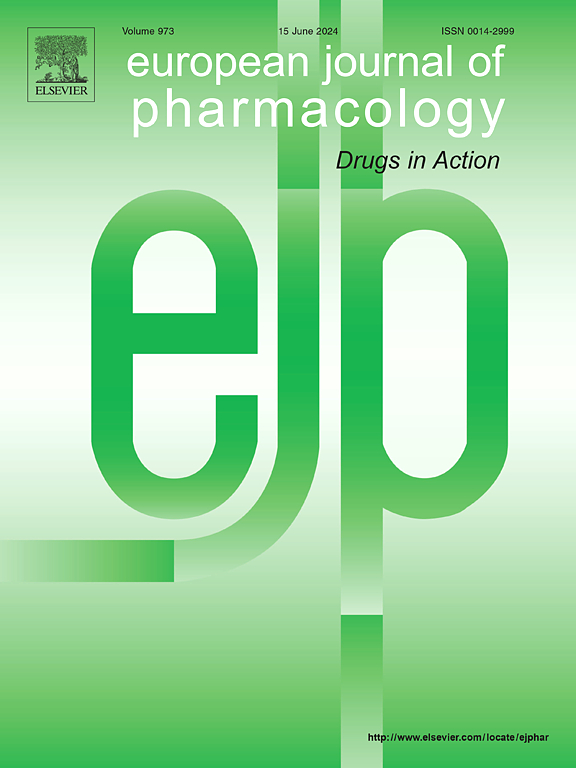Rhoifolin、黄芩素 5,6-二甲醚和龙葵黄酮通过增加 bdnf、nyy、egr-1、nfr2α 和 creb1 基因的 mRNA 表达,防止东莨菪碱诱导的斑马鱼(Danio rerio)模型失忆。
IF 4.7
3区 医学
Q1 PHARMACOLOGY & PHARMACY
引用次数: 0
摘要
随着人们对老年相关疾病的关注与日俱增,与阿尔茨海默病(AD)相关的认知功能障碍这一概念也引起了人们的极大兴趣。据报道,黄酮类化合物由于其抗氧化、抗炎和抗淀粉样蛋白生成的特性,在几种阿尔茨海默病模型中表现出多种生物活性和抗阿尔茨海默病的作用。在本研究中,我们对三种类黄酮(荷叶黄素、黄芩素 5,6-二甲醚和龙葵黄酮)的药代动力学特性进行了初步的硅学预测。随后,我们评估了黄酮类化合物在东莨菪碱(100 μM)诱导的失忆斑马鱼(Danio rerio)模型中1、3和5 μg/L浓度的抗失忆和抗氧化潜力。斑马鱼的行为分析包括新颖水槽潜水试验(NTT)、Y迷宫和新颖物体识别试验(NOR)。研究还测定了乙酰胆碱酯酶(AChE)活性、大脑抗氧化状态以及bdnf、nyy、egr1、nrf2α、creb1基因的表达和CREB-1蛋白水平,以阐明其潜在的作用机制。我们的黄酮类化合物改善了斑马鱼的记忆力,并减少了东莨菪碱诱导的失忆的焦虑行为。此外,所研究的黄酮类化合物还降低了乙酰胆碱酯酶活性和脑氧化应激,并上调了基因表达,这些共同促成了黄酮类化合物的神经保护特性。我们的研究结果为黄酮类化合物通过调节参与突触可塑性、轴突生长和引导、交感神经和迷走神经传导、抗氧化反应以及细胞增殖和生长调控的基因表达来调控神经退行性疾病(尤其是老年痴呆症)的演变提供了新的视角。本文章由计算机程序翻译,如有差异,请以英文原文为准。
Rhoifolin, baicalein 5,6-dimethyl ether and agathisflavone prevent amnesia induced in scopolamine zebrafish (Danio rerio) model by increasing the mRNA expression of bdnf, npy, egr-1, nfr2α, and creb1 genes
The increasing attention towards age-related diseases has generated significant interest in the concept of cognitive dysfunction associated with Alzheimer's disease (AD). Certain limitations are associated with the current therapies, and flavonoids have been reported to exhibit multiple biological activities and anti-AD effects in several AD models owing to their antioxidative, anti-inflammatory, and anti-amyloidogenic properties. In this study, we performed an initial in silico predictions of the pharmacokinetic properties of three flavonoids (rhoifolin, baicalein 5,6-dimethyl ether and agathisflavone). Subsequently, we evaluated the antiamnesic and antioxidant potential of flavonoids in concentrations of 1, 3, and 5 μg/L in scopolamine (100 μM)-induced amnesic zebrafish (Danio rerio) model. Zebrafish behavior was analyzed by novel tank diving test (NTT), Y-maze, and novel object recognition test (NOR). Acetylcholinesterase (AChE) activity, brain antioxidant status and the expression of bdnf, npy, egr1, nrf2α, creb1 genes, and CREB-1 protein level was measured to elucidate the underlying mechanism of action. Our flavonoids improved memory and decreased anxiety-like behavior of scopolamine-induced amnesia in zebrafish. Also, the studied flavonoids reduced AChE activity and brain oxidative stress and upregulated the gene expression, collectively contributing to neuroprotective properties. The results of our study add new perspectives on the properties of flavonoids to regulate the evolution of neurodegenerative diseases, especially AD, by modulating the expression of genes involved in the regulation of synaptic plasticity, axonal growth, and guidance, sympathetic and vagal transmission, the antioxidant response and cell proliferation and growth.
求助全文
通过发布文献求助,成功后即可免费获取论文全文。
去求助
来源期刊
CiteScore
9.00
自引率
0.00%
发文量
572
审稿时长
34 days
期刊介绍:
The European Journal of Pharmacology publishes research papers covering all aspects of experimental pharmacology with focus on the mechanism of action of structurally identified compounds affecting biological systems.
The scope includes:
Behavioural pharmacology
Neuropharmacology and analgesia
Cardiovascular pharmacology
Pulmonary, gastrointestinal and urogenital pharmacology
Endocrine pharmacology
Immunopharmacology and inflammation
Molecular and cellular pharmacology
Regenerative pharmacology
Biologicals and biotherapeutics
Translational pharmacology
Nutriceutical pharmacology.

 求助内容:
求助内容: 应助结果提醒方式:
应助结果提醒方式:


